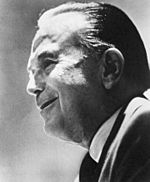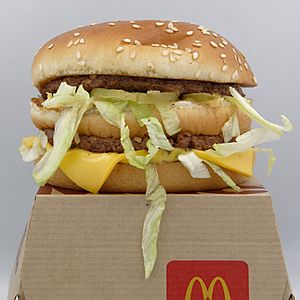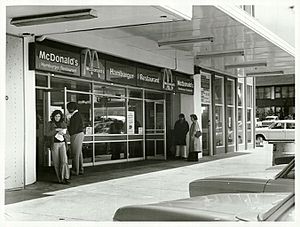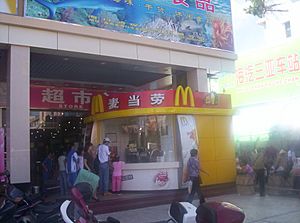History of McDonald's facts for kids
The fast-food restaurant chain McDonald's was founded in 1940 and has since grown to the world's largest restaurant chain by revenue.
Contents
Early history

Founding by Richard and Maurice McDonald
The McDonald family moved from Manchester, New Hampshire to Hollywood, California in the late 1930s, where brothers Richard and Maurice McDonald ("Dick" and "Mac") began working as set movers and handymen at motion-picture studios. In 1937, their father Patrick McDonald opened The Airdrome, a food stand, on Huntington Drive (Route 66) near the Monrovia Airport in the Los Angeles County city of Monrovia.
In October 1948, the McDonald brothers realized that most of their profits derived from the sale of hamburgers. They shuttered their successful carhop drive-in to establish a streamlined system with a simple menu that consisted of only hamburgers, cheeseburgers, potato chips, coffee, soft drinks and apple pie.
In April 1952, the brothers decided that they needed an entirely new building to achieve two goals: further efficiency improvements and a more eye-catching appearance. They collected recommendations for an architect and interviewed at least four, choosing Stanley Clark Meston, who practiced in nearby Fontana. The brothers and Meston worked together closely in the design of the new building. They achieved the extra efficiencies that they needed by, among other things, drawing the actual measurements of every piece of equipment in chalk on a tennis court behind the McDonald house (with Meston's assistant, Charles Fish).
The new design achieved a great deal of notice for its gleaming surfaces of red and white ceramic tile, stainless steel, brightly colored sheet metal and glass; pulsing red, white, yellow and green neon; and two 25-foot yellow sheet-metal arches trimmed in neon, which they named the "Golden Arches" at the design stage. A third, smaller arch sign at the roadside depicted a pudgy character in a chef's hat known as Speedee striding across the top, trimmed in animated neon. The brothers implemented several techniques to encourage customers to eat quickly and not to linger in the restaurant, such as reduced heating in the dining area, fixed and angled seating to place customers directly over their food, distance between seats to reduce socialization and cone-shaped cups, which would force customers to hold their drinks while eating.
In late 1953, with only a rendering of Meston's design in hand, the brothers began seeking franchisees. Their first was Neil Fox, a distributor for General Petroleum Corporation. Fox's stand, the first with Meston's golden arches design, opened in May 1953 at Central Avenue and Indian School Road in Phoenix, Arizona. Their second franchisee was the team of Fox's brother-in-law Roger Williams and Burdette "Bud" Landon, both of whom also worked for General Petroleum. Williams and Landon opened their stand on August 18, 1953 at 10207 Lakewood Boulevard in Downey, California. The Downey stand is the oldest surviving McDonald's restaurant.

Ray Kroc joins and expands franchise operation
In 1954, Ray Kroc, a seller of Prince Castle brand Multimixer milkshake machines, learned that the McDonald brothers were using eight of his machines at their San Bernardino restaurant. His curiosity was piqued, and he visited the restaurant with his friend Charles Lewis, who had suggested to Kroc several improvements to the McDonald's burger recipe. The McDonald brothers operated six franchise locations.
Believing that the McDonald's formula was a ticket to success, Kroc suggested that the brothers franchise their restaurants throughout the United States. The brothers were skeptical that the self-service approach could succeed in colder, rainier climates; furthermore, their thriving business in San Bernardino, and franchises already operating or planned, made them reluctant to risk a national venture. Kroc offered to assume the major responsibility for establishing the new franchises elsewhere. He returned to his home outside of Chicago with rights to set up McDonald's restaurants throughout the country, except in a handful of territories in California and Arizona already licensed by the McDonald brothers. The brothers were to receive 0.5% of gross sales.
Sonneborn model and shift to real-estate holdings
In 1956, Ray Kroc met Harry J. Sonneborn, a former vice president of finance for Tastee-Freez, who offered an idea to accelerate the growth and investment grade of Kroc's planned McDonald's operation: to own the real estate upon which future franchises would be built. Kroc hired Sonneborn and his plan was executed by forming a separate company, Franchise Realty Corp, to hold McDonald's real estate. The new company signed leases and procured mortgages for both land and buildings, passing these costs on to the franchisee with a 20-40% markup and a reduced initial deposit of $950. The "Sonneborn model" of real-estate ownership within the franchise persists to this day, and may be the most important financial decision in the company's history. McDonald's present-day real-estate holdings represent $37.7 billion on its balance sheet, about 99% of the company's assets and 35% of its annual gross revenue.
1960s and 1970s

By 1960, McDonald's restaurants were grossing $56 million annually. The growth in U.S. automobile use that came with suburbanization and the interstate highway system contributed heavily to McDonald's success. In 1961, Kroc's conflict over the vision of the company with the founding brothers had escalated, and he asked them how much money they wanted to leave their business to him entirely. The brothers asked for $2.7 million ($23.4 million in 2021 dollars), which Kroc did not have. Harry J. Sonneborn was able to raise the money for him, and Kroc bought the founding brothers' interests in the company. This purchase laid the groundwork for positioning the company for an IPO and making McDonald's the top fast-food chain in the country. The exact process by which the company was sold is not known; it is depicted as a hostile takeover by Kroc in the 2016 biographical film The Founder, but that portrayal has been disputed, and interviews from the time suggest a more voluntary transition.
Kroc and Sonneborn disagreed over expansion of the company, leading to Sonneborn's resignation in 1967. Kroc took over the title of CEO and president.
McDonald's success in the 1960s was largely the result of the company's skillful marketing and flexible response to customer demand. In 1962, the Filet-O-Fish sandwich, billed as "the fish that catches people," was introduced. In 1967, the Big Mac was created by franchisee Jim Delligatti and was added to McDonald's national menu the next year.

There was some skepticism about the company's phenomenal growth internationally. When Wally and Hugh Morris approached the corporation in 1974 to bring McDonald's into New Zealand, they were firmly shunned by Kroc who, citing a visit to the country, stated, "There aren't any people... I never met a more dead-than-alive hole in my life." The Morris brothers were finally granted a franchise in May 1975. They negotiated a deal with the corporation by selling New Zealand cheese to the U.S. to offset the high costs of importing plant equipment. The first New Zealand restaurant opened in June 1976 at Porirua, near Wellington, to much more success than the corporation had predicted.
1980s – 2020s
The first McDonald's Express locations opened in 1991. These are smaller-scale prototypes, usually constructed in prefabricated buildings or urban storefronts, that do not feature certain menu items such as milkshakes and Quarter Pounders.

The first McDonald's in Mainland China opened in Dongmen, Shenzhen in October 1990.
The Extra Value Meal, a burger, fries and drink combination deal, was introduced from 1993, originally as part of a Jurassic Park tie-in. In 2000, a McDonald's in Dearborn, Michigan in Greater Detroit was the first one in Michigan and the only one east of the Mississippi River to offer halal food for Muslim customers. In January 2012, the company announced that revenue for 2011 reached an all-time high of $27 billion, and that 2,400 restaurants would be updated and 1,300 new ones opened worldwide.
In the middle of the decade, the restaurant began to suffer from declining profits. In response, McDonald's began to offer a limited selection of its breakfast menu all day starting in 2015. At first, the launch was unpopular with franchisees who claimed that the changes caused service to slow down. However, the plan paid off with CNBC reporting that the company's fourth quarter earnings "easily topped analysts' forecasts".

